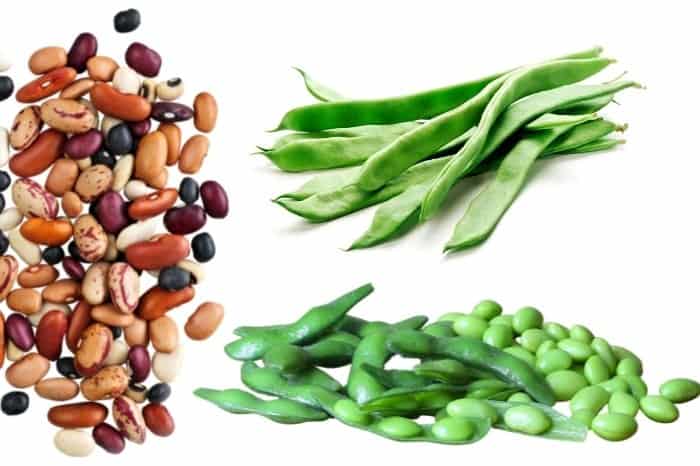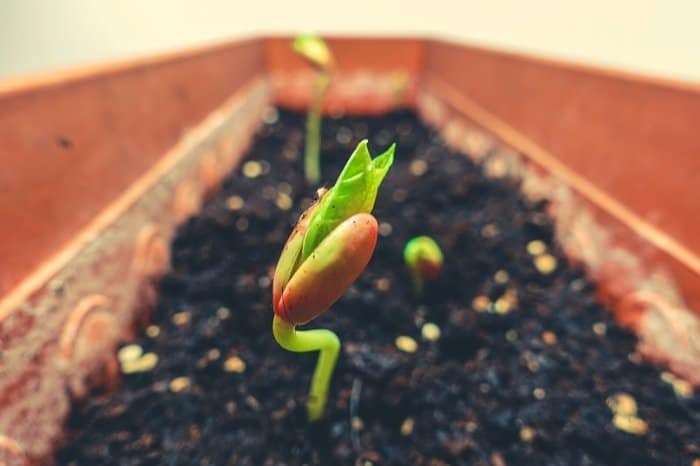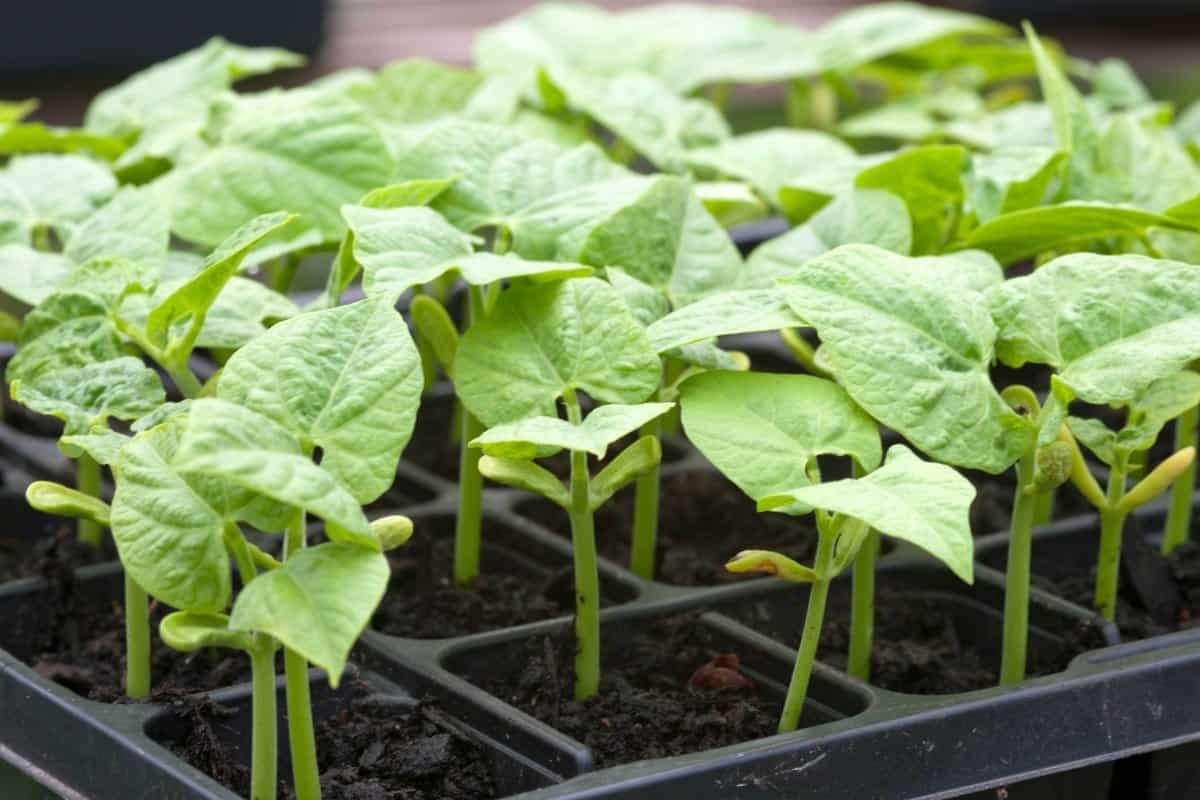Last Updated on February 8, 2022 by
If there is one crop that is fun to grow in your garden, it’s the humble bean that grows easily with no much care, but what do beans grow on?
Most beans grow fast, and you can expect a weekly harvest of tender, tasty pods that are yummy to eat. Bean is the common name given to the seeds of the Fabaceae family that are used for human or animal consumption.
For centuries, beans have been planted for many either dry beans, shelling beans or snap beans.
Types Of Beans
Beans have a large variety that can grow in different areas. Warm-season bean plants are grown and eaten in three nutritious ways.
- Immature pods (snap beans)
- Immature seeds (shell beans)
- Mature seeds (dry beans)

Beans Fall Into Two Categories
Category 1 – The determinant type growth – These grow as a low bush
Category 2 – The indeterminant type – These grow with a vining habit requiring support, also known as pole beans.
- Green Beans. The most familiar beans are the green snap beans that have an edible pod. Today also known as string beans, they lack the tough, stringy fibre along the pods’ seam. Other green beans are no longer green in colour but purple when raw and green when cooked.
- Wax Beans. They are a variant of snap bean with a yellow, waxy pod.
- Lima or Butter Beans are grown for their immature seeds, which are shelled and cooked. These beans have a distinct flavour and are flat and round in shape. This is the most sensitive type of bean.
- Horticultural Beans also known as shelly beans are large-seeded beans that have a tough fiber lined pod. Most of the heirloom varieties are classified as horticultural beans. Their seeds are harvested when the beans are fully formed and shelled while still very soft. Do not allow them to dry out before harvesting them. They can be grown either as pole or bush types. Some examples of horticultural beans are – cowpeas also known as southern peas, black-eyed peas, and crowder peas. Cowpeas are also referred to as southern peas, crowder peas, and blackeye peas. They are, indeed, really a bean and not a pea and are grown as a dry or green shell bean. Kidney, navy, and pinto are all examples of dry use cowpeas.
Organic Microgreens Growing Kit with Beautiful Wooden Countertop Planter
What Do Beans Grow On?
Beans can grow in the garden or pots and planters. When growing them in the garden, raised beds are the best to use as you will have well-aerated soil than just in the garden.
If you are growing bush beans in a pot, choose a large box or a pot that measures at least 15 inches in diameter. For pole beans, get a container that is at least 18 inches in diameter.
Be sure to fill your pots with a high-quality potting mix plus compost for healthy growth.
Anytime you are growing beans in a container, the most important components to consider are
The soil type – select the right soil for beans and other vegetables. You can buy a potting mix, or a vegetable start mix or better still, make your own. Ensure that you use equal parts sphagnum moss or compost with pasteurized soil and perlite. Add fertilizer or compost manure before planting if need be. You may use a soilless potting mix for beans.
- The pot depth
- Drainage capability
- Ambient growing conditions
How To Grow Beans
Growing beans take some important considerations to ensure you do it accordingly. Let’s look at ways to grow your beans.
- Sowing. All beans should be sown after the last day of the frost or when the danger of frost has passed. Ensure that your soil is warm to at least 50 degrees F.Sow all your beans at least 1-inch deep in heavy soil or 1½ inch deep in light soil except cowpea, lima and yard-long. Plant these 3 beans ½ inch in heavy soil and 1 inch deep in light soil. Cover your seeds with perlite, peat or aged manure to prevent soil crusting.
- Spacing. Sow the bush beans at least 2 to 4 inches apart in rows 2 to 3 feet apart. Plant pole beans in rows or hills with the seeds being 6 to 10 inches apart in 3 to 4 feet rows apart.
- Support. Provide support for pole beans to keep them growing straight. These beans are the best to grow when you have limited space. They maximize your space, and when grown straight, they are easier to pick. The bush-type bean plant requires no support. They also require minimal care and can be picked whenever ready to cook them –green or dried. This type produces an earlier crop and is great for successive planting for a continual harvest.
- Fertilizing. Beans do not require supplemental fertilizer, but they need consistent watering. Using compost manure is the best way to grow a good bean crop. The fertilizer, if misused, can give you lots of foliage and less produce. Use fertilizer only if needed.
- Watering. Water the plants with at least 1 inch of water each week, depending on weather conditions. Water them in the morning to allow them to dry rapidly and avoid the fungal disease.

FAQs
What type of plant do beans grow on?
The bean, or Phaseolus vulgaris, grows on the ground. It is an annual plant with a bean-like pod, which can be harvested for food. The bean itself has many uses, including for food, as well as for industrial purposes.
Beans are a member of the legume family, which includes peas and lentils. This family also includes a number of other vegetables and fruits, such as alfalfa, soybeans, peanuts, and clover. All members of this family have pods that contain seeds. The seed in a bean is actually the fruit, or pod, of the plant.
Should I grow beans on the ground?
Yes, but only if you're willing to put up with a lot of work and some frustration. If you're thinking about growing beans, you'll find that they take a lot of space, require a fair amount of care and are prone to a lot of problems. But there is another option available: container gardening.
Container gardening is growing food in a pot or other container instead of planting it directly into the ground. This can be an attractive option for small gardeners who want to grow more vegetables without taking up a large amount of outdoor space. You'll find that container gardens have a few advantages over traditional gardening methods.
Is the depth of the container important?
You don't need to be too concerned about depth. The only issue is the size of the container you are filling, and how much air space you have above the beans. The general rule is that the beans should be at least as deep as the diameter of your largest bean.
How do you plant beans?
Beans are easy to grow. All you need is a pot, some dirt, and the right kind of bean seed. Plant the beans directly into your containers, and then add a little water and fertilizer. You can also put them inside the ground at this time, but they need to be very well-watered after planting, and you'll want to fertilize them later. This is what I'd do: Pour some fertilizer into the bottom of the pot.
Place the plant in the center of the pot. Add water until the soil is about an inch deep, and wait for it to drain away. After a couple of days, you can fertilize the soil, or just water again if it's dry. If you're using the topsoil from your garden, you might want to add a little extra fertilizer to it before planting.
When can you plant beans outside?
You can plant beans outside as early as the last week of April in northern climates and as late as the first week of June in southern climates. In most areas, though, you’ll want to wait until after Memorial Day, May 25.
Can you transplant beans?
Bean plants can be started indoors and transplanted outside once they have been hardened off (see this page for more on hardening off). If you live in a cold climate, you may need to start your seeds indoors or protect them from frost until the weather warms up.
Conclusion
FAQs
What type of plant do beans grow on?
The bean, or Phaseolus vulgaris, grows on the ground. It is an annual plant with a bean-like pod, which can be harvested for food. The bean itself has many uses, including for food, as well as for industrial purposes.
Beans are a member of the legume family, which includes peas and lentils. This family also includes a number of other vegetables and fruits, such as alfalfa, soybeans, peanuts, and clover. All members of this family have pods that contain seeds. The seed in a bean is actually the fruit, or pod, of the plant.
Should I grow beans on the ground?
Yes, but only if you're willing to put up with a lot of work and some frustration. If you're thinking about growing beans, you'll find that they take a lot of space, require a fair amount of care and are prone to a lot of problems. But there is another option available: container gardening.
Container gardening is growing food in a pot or other container instead of planting it directly into the ground. This can be an attractive option for small gardeners who want to grow more vegetables without taking up a large amount of outdoor space. You'll find that container gardens have a few advantages over traditional gardening methods.
Is the depth of the container important?
You don't need to be too concerned about depth. The only issue is the size of the container you are filling, and how much air space you have above the beans. The general rule is that the beans should be at least as deep as the diameter of your largest bean.
How do you plant beans?
Beans are easy to grow. All you need is a pot, some dirt, and the right kind of bean seed. Plant the beans directly into your containers, and then add a little water and fertilizer. You can also put them inside the ground at this time, but they need to be very well-watered after planting, and you'll want to fertilize them later. This is what I'd do: Pour some fertilizer into the bottom of the pot.
Place the plant in the center of the pot. Add water until the soil is about an inch deep, and wait for it to drain away. After a couple of days, you can fertilize the soil, or just water again if it's dry. If you're using the topsoil from your garden, you might want to add a little extra fertilizer to it before planting.
When can you plant beans outside?
You can plant beans outside as early as the last week of April in northern climates and as late as the first week of June in southern climates. In most areas, though, you’ll want to wait until after Memorial Day, May 25.
Can you transplant beans?
Bean plants can be started indoors and transplanted outside once they have been hardened off (see this page for more on hardening off). If you live in a cold climate, you may need to start your seeds indoors or protect them from frost until the weather warms up.
We have been growing beans since we were young and our love for green and yellow beans keep growing daily.
For most gardeners, green beans remain one of the most favourite crops to grow and eat. They are easy and quick to grow to make them a perfect vegetable for novice gardeners.
Once your green beans are ready, it’s essential to pick once, pick again and pick some more. It is best to pick them when they are young and slender because they are tender and yummy. If you leave them for too long, they will turn tough and stringy and are not delicious to eat. When you stop picking the beans, the produce comes to a halt.
If you have never grown beans before, you can start with the bush and pole beans for the longest harvest season. Plant them in raised beds or planters at the start of spring, and be sure you will get a harvest in the coming days.
Caroline is a gardener who loves to get down to the nitty–gritty of gardening. She proudly proclaims herself as a ‘dirt worshipper‘ and can often be found deep in the garden, covered in soil and singing to her plants. As a self–proclaimed ‘plant whisperer‘, Caroline believes that plants need love and attention just like any other living thing, and she loves to give them both. When she‘s not tending to her garden, you can often find her researching the latest gardening trends, or teaching others how to make their gardens thrive



